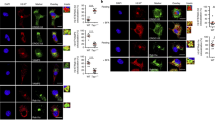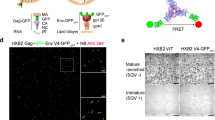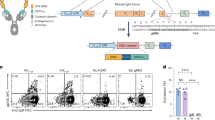Abstract
CDS+ cytolytic T lymphocytes (CTL) identify virally infected cells by recognizing processed viral antigen in association with class I major histocompatibility complex (MHC) molecules on infected cells1–4. Processing begins in the cytosol5–7 with the generation of peptides, possibly by a protease complex with MHC-encoded subunits, known as the proteasome8–11. Transport of the resulting cytosolic peptides into the endoplasmic reticulum for association with class I molecules is essential and probably involves a heterodimer of the MHC-encoded proteins, Tap-1 and Tap-212–17. The site of processing of viral envelope proteins is uncertain. These proteins are not present in the cytosol because of cotranslational translocation into the endoplasmic reticulum. We show here that the HIV-1 envelope (env) protein is processed in infected cells by a novel Tap-l/Tap-2-independent pathway that seems to be localized to the endoplasmic reticulum.
This is a preview of subscription content, access via your institution
Access options
Subscribe to this journal
Receive 51 print issues and online access
$199.00 per year
only $3.90 per issue
Buy this article
- Purchase on SpringerLink
- Instant access to full article PDF
Prices may be subject to local taxes which are calculated during checkout
Similar content being viewed by others
References
Townsend, A. R. M., Gotch, F. M. & J. Davey Cell 42, 457–467 (1985).
Gooding, L. R. & O'Connell, K. O. J. Immun. 131, 2580–2586 (1983).
Morrison, L. A., Lukacher, A. E., Bracile, V. L., Fau, D. & Braciale, T. J. J. exp. Med. 163, 903–913 (1986).
Germain, R. N. Nature 322, 687–689 (1986).
Townsend, A. R. M., Bastin, J., Gould, K. & Brownlee, G. G. Nature 324, 575–577 (1986).
Moore, M., Carbone, F. R. & Bevan M. J. Cell 54, 777–785 (1988).
Yewdell, J. W., Bennick, J. R. & Hosaka Y. Science 239, 637–640 (1988).
Monaco, J. J. & McDevitt H. O. Nature 309, 797–799 (1984).
Brown, M. G., Driscoll, J. & Monaco, J. J. Nature 353, 355–357 (1991).
Glynne, R. et al. Nature 353, 357–360 (1991).
Ortiz-Navarrete, V. et al. Nature 353, 662–664 (1991).
Deverson, E. et al. Nature 348, 738–741 (1990).
Trowsdale, J. et al. Nature 348, 741–744 (1990).
Spies, T. et al. Nature 348, 744–747 (1990).
Monaco, J. J., Cho, S. & Attaya, M. Science 250, 1723–1726 (1990).
Kelly, A. et al. Nature 355, 641–644 (1992).
Kleijmeer, M. J. et al. Nature 357, 342–344 (1992).
Walker, B. D. et al. Nature 328, 345–348 (1987).
Plata, F. et al. Nature 328, 348–351 (1987).
Koenig, S. et al. Proc. natn. Acad. Sci. U.S.A. 85, 8638–8642 (1988).
Salter, R. D., Howell, D. N. & Cresswell, P. Immunogenetics 21, 235–246 (1985).
DeMars, R. et al. Proc. natn. Acad. Sci. U.S.A. 82, 8183–8187 (1985).
Cerundolo, V. et al. Nature 345, 449–452 (1990).
Hosken, N. A. & Bevan, M. J. Science 248, 367–370 (1990).
Anderson, K. et al. J. exp. Med. 174, 489–492 (1991).
Townsend, A. et al. Nature 340, 443–448 (1989).
Wei, M. L. & Cresswell, P. Nature 356, 443–446 (1992).
Lippincott-Schwartz, J., Bonifacino, J. S., Yuan, L. C. & Klausner, R. D. Cell 54, 209–220 (1988).
Wilstrom, L. & Lodish, H. F. J. Cell Biol. 113, 997–1007 (1991).
Jardetzky, T. S., Lane, W. S., Robinson, R. A., Madden, D. R. & Wiley, D. C. Nature 353, 326–329 (1991).
Lie, W.-R. et al. Nature 344, 439–441 (1990).
Ljunggren, H.-G. et al. Nature 346, 476–480 (1990).
Kvist, S. & Hamann, U. Nature 348, 446–448 (1990).
Often, G. R. et al. J. Immun 148, 3723–3732 (1992).
Henderson, R. A. et al. Science 255, 1264–1266 (1992).
Folz, R. J. & Gordon, J. I. Biochem. biophys. Res. Commun. 146, 870–877 (1987).
van Binnendijk et al. J. exp. Med. 176, 119–128 (1992).
Ohlen, C. et al. J. Immun. 145, 52–58 (1990).
Aldrich, C. J. et al. J. Immun. 149, 3773–3777 (1992).
Willey, R. L., Bonifacino, J. S., Potts, B. J., Martin, M. A. & Klausner, R. D. Proc. natn. Acad. Sci. U.S.A. 85, 9580–9584 (1988).
Haffar, O. K., Nakamura, G. R. & Berman, P. W. J. Virol. 64, 3100–3103 (1990).
Crise, B., Buonocore, L. & Rose J. K. J. Virol. 64, 5585–5593 (1990).
Earl, P. E., Hugin, A. W. & Moss B. J. Virol. 64, 2448–2451 (1990).
Earl, P. L., Koenig, S. & Moss, B. J. Virol. 65, 31–41 (1991).
Polydefkis, M. et al. J. exp. Med. 171, 875–887 (1990).
Hammond, S. A. et al. J. exp. Med. 176, 1531–1542 (1992).
Orentas, R. J. et al. Science 248, 1234–1237 (1990).
Buonocore, L. & Rose, J. K. Nature 345, 625–628 (1990).
Chesebro, B. & Wehrly, K. J. Virol. 62, 3779–3785 (1988).
Callahan, K. C. et al. J. Immun. (in the press).
Author information
Authors and Affiliations
Rights and permissions
About this article
Cite this article
Hammond, S., Bollinger, R., Tobery, T. et al. Transporter-independent processing of HIV-1 envelope protein for recognition by CD8+ T cells. Nature 364, 158–161 (1993). https://doi.org/10.1038/364158a0
Received:
Accepted:
Issue date:
DOI: https://doi.org/10.1038/364158a0
This article is cited by
-
Generation of MHC class I ligands in the secretory and vesicular pathways
Cellular and Molecular Life Sciences (2011)
-
Translating DRiPs: progress in understanding viral and cellular sources of MHC class I peptide ligands
Cellular and Molecular Life Sciences (2011)
-
A Plasmodium vivax Vaccine Candidate Displays Limited Allele Polymorphism, Which Does Not Restrict Recognition by Antibodies
Molecular Medicine (1999)
-
Computer simulations to predict the availability of peptides with known HLA class I motifs possibly generated by proteolysis of HIV-1 proteins in infected cells
Virus Genes (1995)



